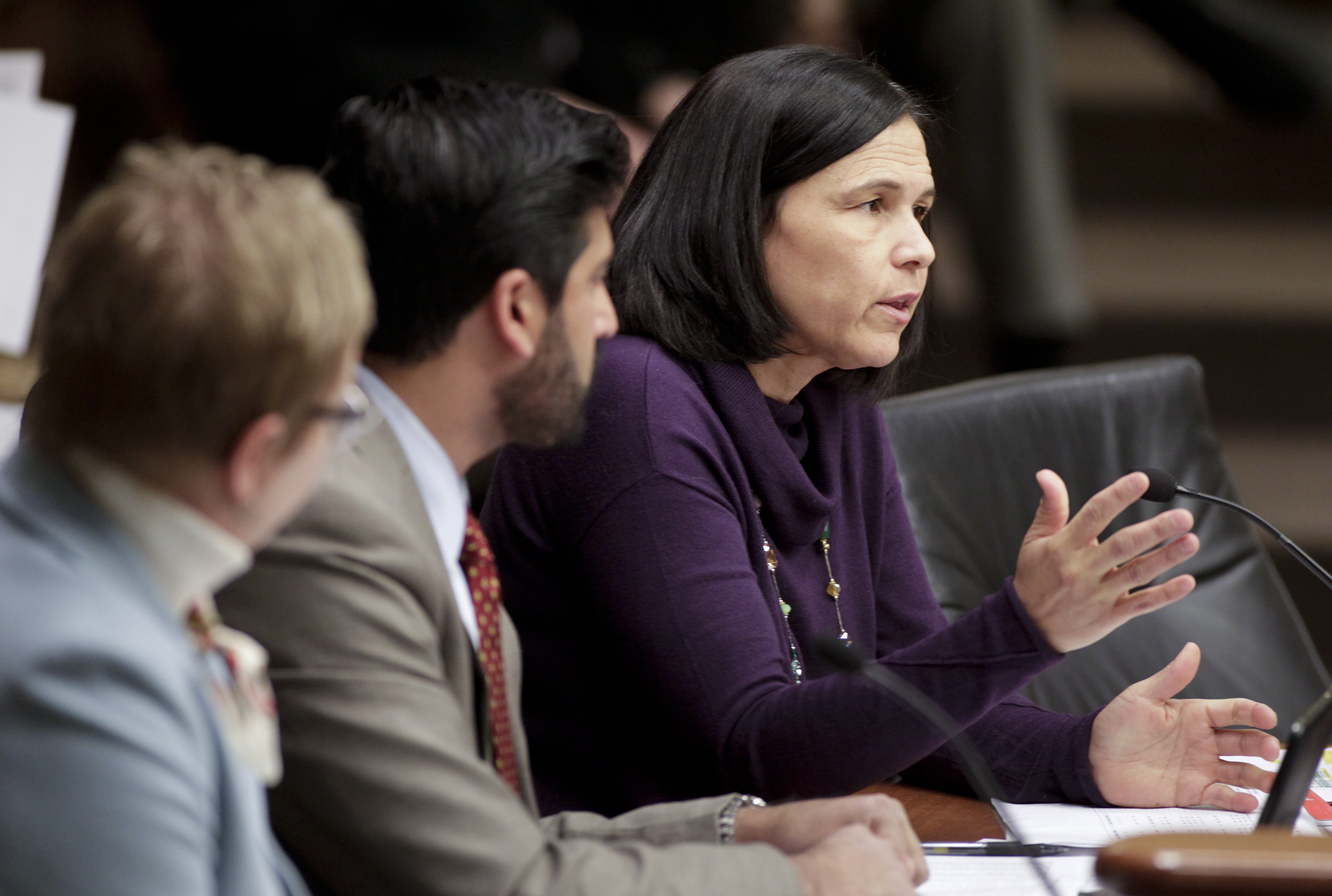Legislators dissect Dayton’s proposed $373 million bump in education spending
The state’s littlest learners are a major focus of Gov. Mark Dayton’s education budget proposal, which calls for a $373 million increase in spending over the next biennium. Those expenditures were presented in bill form on Wednesday to the House Education Finance Committee.
Sponsored by Committee Chair Rep. Jenifer Loon (R-Eden Prairie), HF844 reflects the governor’s goals to close the achievement gap by ramping up support for early learning, particularly for children who come from low-income families, said Education Commissioner Brenda Cassellius.
“In terms of closing achievement gaps, we are targeting funding to the students we believe that need it most,” she said.
 Education Commissioner Brenda Cassellius answers a member’s question while presenting the governor’s proposed biennial education budget to the House Education Finance Committee Feb. 18. Photo by Paul Battaglia.
Education Commissioner Brenda Cassellius answers a member’s question while presenting the governor’s proposed biennial education budget to the House Education Finance Committee Feb. 18. Photo by Paul Battaglia.That amounts to what Dayton and the Department of Education are referring to as a “scaling up” of 4-year-old, half-day pre-kindergarten programs in the public schools over the next several years. The goal, Cassellius said, is to develop a voluntary, pre-kindergarten option for school districts and parents to ensure that every 4-year-old has an opportunity to receive early learning education to prepare them for kindergarten. That would not eliminate the option for parents to enroll their children in non-public school early education.
Those investments amount to $138 million increase in funding over the 2016-17 biennium.
The committee took no action. Loon would not rule out the bill ultimately becoming a vehicle for the omnibus education funding bill.
Its companion, SF811, sponsored by Sen. Chuck Wiger (DFL-Maplewood), awaits action by the Senate Education Committee.
The bill also calls for a $28.1 million increase to expand free in-school breakfast programs for pre-kindergarteners through third graders.
Those provisions drew questions from several committee members, whose concerns ranged from how a “scaling up” of pre-kindergarten in the public schools would impact school district expenditures and licensure issues for a new crop of teachers to whether the free breakfast expansion would prove to be an efficient use of dollars.
Rep. Sondra Erickson (R-Princeton) believes many rural school districts will not be pleased to learn Dayton’s proposal would eliminate the School Readiness program that specifically targets low-income families in favor of the voluntary pre-kindergarten program that she said will also likely cause a bureaucratic licensing headache for many districts.
Rep. Anna Wills (R-Apple Valley) said she has spoken with constituents who help run the breakfast and lunch programs for the Rosemount-Apple Valley-Eagan School District. They said they’ve seen a sharp decrease in participation in the state’s already existing free breakfast program for kindergarteners.
“They initially saw about 2,000 students participating. And then saw it drop off to about 500 students participating because in our district most students come to school having already had breakfast,” Wills said before adding that schools have had to change bus routes and schedules just to get students to school on time for the breakfast program, which she said has resulted in loss of in-class instruction time.
Other committee members, including Rep. Paul Marquart (DFL-Dilworth), praised Dayton’s early education initiatives.
“I just want to thank the department and the governor for bringing forward a plan that really targets the areas that we know make the biggest difference in closing the achievement gap,” he said.
Other provisions in the bill include:
- a 1 percent increase in the per-pupil formula across all school districts, which Cassellius said helps keep districts fiscally sound to adjust for inflation;
- creation of a 0.5 per-pupil funding formula for each student enrolled in a free all-day, every day prekindergarten program;
- a requirement that schools that opt to create pre-k programs have a maximum child-to-staff ratio of 10:1;
- authorization of early learning scholarships for children from birth to age 5 who are not enrolled in the full-day prekindergarten program (scholarships are income-based, targeted to low income families); and
- an increase in the maximum number of years that state funding for English language services may be provided to an English language learner from six to seven, and an inclusion of prekindergarten students in the funding formula.
Related Articles
Search Session Daily
Advanced Search OptionsPriority Dailies
Ways and Means Committee OKs proposed $512 million supplemental budget on party-line vote
By Mike Cook Meeting more needs or fiscal irresponsibility is one way to sum up the differences among the two parties on a supplemental spending package a year after a $72 billion state budg...
Meeting more needs or fiscal irresponsibility is one way to sum up the differences among the two parties on a supplemental spending package a year after a $72 billion state budg...
Minnesota’s projected budget surplus balloons to $3.7 billion, but fiscal pressure still looms
By Rob Hubbard Just as Minnesota has experienced a warmer winter than usual, so has the state’s budget outlook warmed over the past few months.
On Thursday, Minnesota Management and Budget...
Just as Minnesota has experienced a warmer winter than usual, so has the state’s budget outlook warmed over the past few months.
On Thursday, Minnesota Management and Budget...